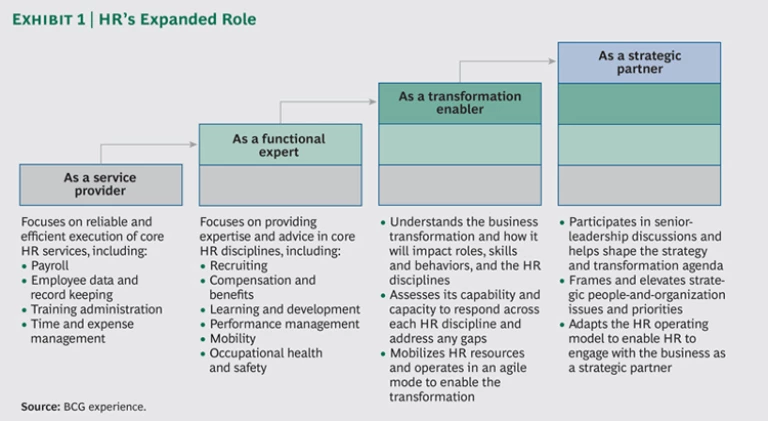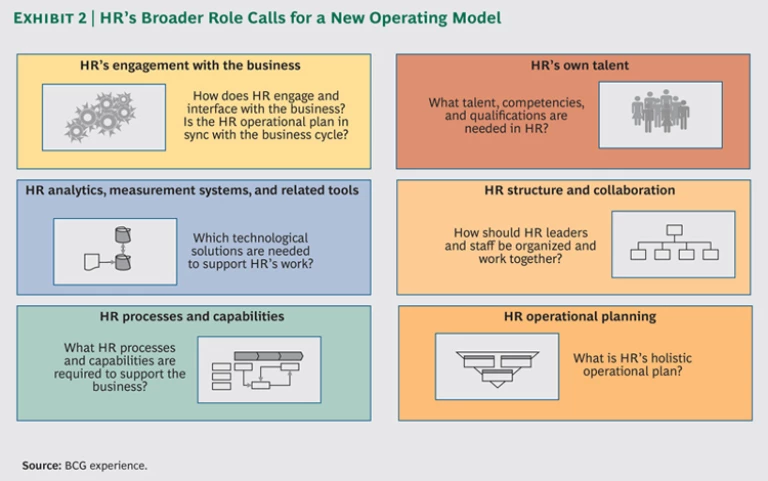Technology companies today face unprecedented change. Consider some of the major shifts now under way: from hardware to software, from point products to platform positions, from on-premises to cloud computing, from waterfall to agile software development, from selling products to selling solutions. As throughout the broader economy, in technology, traditional products are becoming commoditized, and nimbler emerging companies with stronger business models are routinely and readily outpacing dominant market players.
To compete in the maelstrom of today’s markets, established technology companies must transform. Now. And swiftly. As one chief human resources officer (CHRO) told us, “It’s insane to think that you have 18 months to make a transformation stick.”
If transformation is urgent, so is the realization that it’s not only about strategy and processes. It’s about the most crucial asset technology companies have: people. And the impacts of change in the industry on people and the organization are enormous.
The implications of these changes and the challenges they pose for HR organizations are equally enormous. From talent needs to organization structure, the pressures to transform the role of the CHRO—and the entire HR function—are escalating. Yet in all too many technology companies, HR struggles to meet these challenges. It’s time for technology companies to formulate a new view of HR and forge a deeper partnership between HR and the business. Doing so will require a fundamental change in HR strategy and operations.
The Impacts on People and Organizations
Industry shifts are straining technology companies’ operating models, ways of working, and talent needs to the breaking point. Consider the following trends.
The Economic Imperative: Driving Growth While Preserving Margins. Although overall industry growth is a modest 3 percent, certain spheres are growing briskly: notably, public cloud services (projected compound annual growth rate from 2013 through 2018: 17 percent) and mobile-enterprise security (projected CAGR from 2012 through 2017: 23 percent). However, core businesses (such as on-premises applications and hardware) increasingly face commoditization. Companies must therefore boost investment in high-growth areas (such as cloud computing) as they squeeze out costs from their mature business lines. Since the commoditized businesses subsidize the new high-growth areas, the challenge is to recoup margins in those areas faster than they are being lost in the commoditized areas.
The Emergence of Hybrid Business Models. Managing the core (legacy) business alongside new growth areas requires maintaining two different operating models: one (legacy) optimized for efficiency and one (growth) optimized for speed to market. Larger companies must decide whether to integrate or segregate the two disparate models. Regardless of its size, any company with a hybrid operating model must compete for talent against pure-growth companies.
Another challenge for hybrids: managing two employee value propositions without friction. Layoffs in the mature business lines make it hard to keep talent. Meanwhile, the unrelenting demand for talent in the fast-growth areas calls for an irresistible value proposition that competitors can’t match.
The War for the Right—and Best—Talent. Skill shortages are rampant: in security (200,000 unfilled positions in the U.S. alone), enterprise applications, systems engineering, and cloud storage. Programmers skilled in certain languages, as well as technical and specialized salespeople, are also in short supply. (See Code Wars: The All-Industry Competition for Software Talent, BCG Focus, May 2014.)
But the problem isn’t just skill shortages. An even bigger issue is the war for the best and the brightest—what Google calls smart creatives. Attracting, deploying, and retaining such talent, simultaneously addressing specific skill shortages, dramatically escalates the war for talent. It’s tough for mainstream companies to compete against high-growth companies, with their innovation appeal and tempting compensation packages. Furthermore, Millennials are more motivated by a sense of mission and leaders who make them feel appreciated than by an extra $300 in the monthly paycheck. (See Decoding Global Talent , BCG report, October 2014.)
The Need to Collaborate Across Boundaries. Many well-established technology companies have grown on the back of a single flagship product. Today, companies are competing across product categories, and with the rise in integrated solutions, silos are merging. Employees must be able to easily navigate functional and product boundaries to achieve the collaboration needed to deliver these more holistic solutions. Then, as boundaries begin to dissolve, and once-separate groups combine into single teams (a services, sales, and engineering team, for example), roles will need to be redefined.
The Need for New Ways of Working. Agile development and solution-based selling are forcing the development of new processes and new operating models. Core business processes—such as product development—are following new rhythms, creating new handoff points, and dictating new deliverables. Development deadlines, sales cycle times, service feedback loops, and other time lines will inevitably compress. It is essential to ease collaboration across product teams and functions, with customers, and even with ecosystem partners. As product teams broaden, spans of control will likewise broaden, necessitating changes in evaluation and compensation models.
Rising to the Challenge: The New HR Manifesto
HR’s role must fundamentally change. No longer can HR be a supporting player. It must assume a leading role as a strategic partner in driving and orchestrating transformation.
HR must understand the requirements of the transformation and how these impact HR. It must craft its own vision of how people and the organization will enable the strategy. HR must anticipate the people and organizational implications of every change initiative. It must know whether the company has the capability and the capacity to meet its strategic goals. All the while, HR must keep pace with the organization as the transformation unfolds, operating with agility and in real time.
An Expanded Role
HR cannot shed its traditional responsibilities, such as performance reviews, talent searches, and benefits. But it must move far beyond the role of service provider and take on broader and deeper organizational challenges.
As Exhibit 1 shows, HR’s expanded role involves more than a linear change. Each step requires a deepening of capabilities. For example, increasing cost pressures require greater efficiencies in providing services. HR must also fortify its functional expertise so that it can serve the business more effectively. Professionals must work side by side with line leaders, providing them with the support they need in organization design, change management, and other critical activities.
Because people and talent are the key—or the key obstacle—to growth, HR must be proactive in the transformation effort. In that way, it will win the confidence and trust of senior leaders and elevate its position to that of partner.
The challenge for many HR organizations is winning the credibility to take on this expanded role. This can present a chicken-and-egg dilemma. Many HR professionals aren’t viewed as true partners by CEOs. Traditionally, their role hasn’t required that they perform in these new ways, so they’ll need to demonstrate their ability and willingness to earn a seat at the table.
HR will also need the capacity to evolve in real time. Constantly changing customer and market demands aren’t the exclusive province of the business functions. The HR organization needs its finger on the pulse of the dynamics of both the company and the industry. It needs its eye on the future. And it needs the ability to anticipate and adapt to change. A CHRO for a social-media company recently told us that HR’s mandate in the transformation goes beyond its traditional role. “HR is the ignition for the innovation engine,” he said. It can be the unbiased arbiter in some of the more contentious decisions that accompany a transformation.
A New Operating Model
To broaden its role and develop new capabilities, HR must alter how it operates in several areas, including the following. (See Exhibit 2.)
HR’s Engagement with the Business. To keep pace with the many changes in the business, HR will need to be more proactive, responsive, and flexible. HR must be integrally linked to the business at higher levels. Netflix is a noteworthy example: CEO Reed Hastings and Patty McCord, who was at the time the chief talent officer, collaborated on a piece defining how Netflix shaped culture, motivated performance, and managed talent. The document (which went viral) exemplifies HR’s partnership with the business—at the highest level, both in leadership and strategic import.
HR’s Own Way of Working. HR organizations are just as silo afflicted as the line businesses. Worse, each client-facing group tends to serve its silo at the expense of working in concert with the larger HR organization to leverage HR’s efforts. For example, in many cases, local HR departments, mistrusting centers of excellence, do the work themselves. So activities that demand a consistent, enterprise-wide approach (such as strategic workforce planning) are undermined. Instead, HR needs to change from loose confederation to “one HR.”
HR’s Own Talent. The traditional skill set of HR professionals can leave them unprepared for the more strategic challenges they face. They’ll need more high-performance skills and behaviors, such as the ability to counsel business leaders as partners and the capacity to manage the people elements of any business change, whether it is a restructuring or a new-system implementation. Above all, the CHRO needs to determine what talent is needed to fill all of HR’s roles and ensure that everyone works together to create a more effective HR organization.
The Use of Analytics, Measurement Systems, and Related Tools. It’s time for HR organizations to get “religious” about data. Powerful tools and methodologies can inform and improve people decisions. Analytics can be used to create a profile of the most innovative employees or to pinpoint the reason for high attrition among a particular cohort (both, Google practices). Other tools can help analyze future talent requirements or track the efficiency and effectiveness of service delivery.
Retooling Processes, Upgrading Capabilities
To fulfill its new role as transformation enabler, HR will also need to retool core processes and upgrade its capabilities. Seven critical areas will need attention.
Organization Design. Frequent product and strategy shifts will call for regular modification of the organization structure. Line business leaders, together with HR, should decide how the organization needs to change. Then, HR should orchestrate the process, bringing the right people together and ensuring that they address the critical questions and their implications. HR also needs to be proactive in managing surge capacity within the organization design, analyzing and guiding decisions about whether to outsource or develop internal capability.
The greater challenge, though, is associated with the increased complexity of organization design. Traditionally, HR professionals have had little experience designing organizations that address the major shifts now under way. Now, as functional dividing lines crumble and hybrid operating models become more prevalent, HR must be able to drive and orchestrate the needed changes in organization design.
Employee Engagement and Culture. Establishing a high-performance culture is crucial for aligning people with the strategy and securing employee engagement, as well as for attracting and retaining the best talent. HR must ensure that the company’s cultural identity includes such critical attributes as customer focus, the willingness to take risks, collaboration, and agility. Although culture change happens within the business lines, HR is responsible for fostering it through leadership role modeling, performance management policies and practices, rewards and incentives and people policies, and even the physical workspace design. (See High-Performance Culture , BCG Focus, June 2013.)
Strategic Workforce Planning. In a more volatile operating environment, strategic workforce planning is a continuous process—one that HR must instigate and coordinate. HR must also take the lead in assessing and anticipating emerging skill gaps and in developing site strategies to fulfill future talent needs. That includes determining which levers—training, sourcing, or acquisitions—to activate to fill talent gaps.
Talent Acquisition and Retention. Acquiring talent will require new, unconventional, and more far-reaching pipelines and strategies. Among them: recruiting college freshmen and sophomores with the aim of securing talent earlier and implementing programs that seed the supply of science, technology, engineering, and mathematics talent for the future. Managing the company’s brand (by, for example, promoting its appearance on best-places-to-work lists) will remain important. But increasingly, companies will need more creative targeted tactics, such as sponsoring “hackathons” to discover technical talent and offering scholarships to lock in the best of the best.
Retention will also call for fresh approaches that satisfy Millennials’ need for intrinsic rewards. Google, for instance, structures small teams around its high-impact smart creatives. These teams thrive in an environment of open dialogue and brainstorming.
Learning and Development. Companies have to either invest in learning and development or form a strategy that can support perpetual personnel churn. More important, companies need to abandon the traditional notion that learning and development equal training. Experiential learning is vital. Leading companies orchestrate rotations—or simply put smart people into jobs at which they learn by doing.
Leadership Development. To help leaders drive growth, lead transformation, and develop future leaders, HR needs to define the critical competencies and devise a way to assess them. HR also needs to coach managers with agility and vision who are adept at navigating change. (See “ Adaptive Leadership ,” BCG Perspective, December 2010.)
Compensation and Performance Management. These areas require a complete overhaul. New incentive models are needed to promote new growth businesses and solution selling. Targeting specific talent pools will call for developing differentiated compensation strategies and creative new perks, such as leave-of-absence policies.
To adapt to the motivation profile of Millennials, some companies are abandoning annual reviews and stack rankings. They’re adopting performance management systems that feature more regular feedback, less emphasis on ratings, and more measurements pertaining to “living the culture.”
The Leadership Imperative
Putting people first in transforming technology companies is not a lofty idea; it is a matter of practical necessity.
HR is naturally positioned to be a critical enabler of transformation. But answering that call means that HR must change. It must contribute to shaping people strategies and setting the transformation agenda. It must fortify its own core capabilities and transform the way it operates. HR needs its own version of “agile,” experimenting and learning as it grows.
CHROs today should possess creativity, vision, and their own form of operational expertise. They must be decisive and confident in their business judgments if they (and their organizations) are to act as—and be seen as—strategic partners of business leaders. To govern a transformational function, CHROs need to have transformational leadership abilities: the capacity to envision the future, an entrepreneurial mindset, agility, and the willingness to take risks.
Because putting people first is paramount, CEOs should lead the charge in calling for HR’s expanded role. It is no longer acceptable for CEOs to hold onto low expectations about HR’s potential contributions or to overlook its role. Such attitudes only threaten a company’s ability to operate in a world of constant disruption.
What might a changed HR look like? One CHRO’s experience captures it perfectly. When called in for her annual review, she was surprised (and encouraged) by the CEO’s approach: “First,” he said, “let’s talk about our company’s plan for the coming year. Where do you think we should be headed?”
Ultimately, putting people first in transforming technology companies is a call to leaders: CEOs must revise their view, reset expectations, and advance partnership; line business leaders must engage; and CHROs must embrace the challenge and step up to become transformation partners. Nothing less than the enterprise’s ability to compete and win depends on it.










